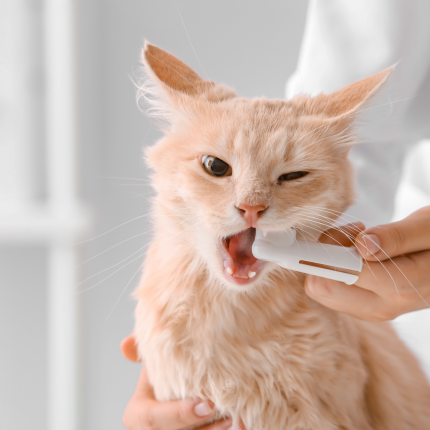The Importance of Brushing Your Cat’s Teeth

Maintaining good oral hygiene for your feline friend is essential, as periodontal disease affects many cats over four years old. Starting as gingivitis, caused by plaque interacting with the gums, this condition can progress to more severe periodontal disease if left untreated. Tartar formation occurs when plaque thickens and mineralizes, potentially leading to painful complications and tooth loss.
When should you brush your cat’s teeth?
Like humans, cats require daily dental care to minimize plaque buildup and prevent tartar accumulation. Teaching your cat to accept tooth brushing requires training but becomes easier with time. Daily brushing is most effective and helps establish a routine, but a minimum of three times a week is recommended to remove plaque and prevent tartar buildup.
Ideally, introducing tooth brushing while your cat is still a kitten yields the best results. However, if you have an older cat, it may take more time and patience. Nonetheless, the effort is worthwhile.
What steps should you follow to train your cat for tooth brushing?
To ensure successful tooth brushing sessions and create a positive experience for both you and your cat, follow these steps:
- Choose a quiet and secure location to begin. Use a small room to place your cat on a counter or tabletop covered with a blanket or towel. Ensure the area can be closed off to prevent escape.
- Take a cotton swab (Q-tip) and dip it into tuna water drained from a can. Although tuna water does not provide dental benefits, its taste appeals to cats. This will establish a positive association between the toothbrushing experience and the taste of tuna juice.
- Position your cat’s head at a 45-degree angle and gently retract her lips, keeping the mouth closed.
- Rub the cotton swab along the gumline where the gums meet the tooth surface (gingival margin). Pay attention to the outer surfaces of the teeth. Start with a few teeth initially, especially if your cat is uncertain or nervous.
- Once your cat is comfortable with the cotton swab, use a toothbrush.
What type of toothbrush should you use?
Various toothbrushes specifically designed for cats are available, including angled handles, tiny brushes that fit comfortably in your hand, and finger toothbrushes. Soft toothbrushes intended for human babies can also be used in some cases. Consult your veterinarian if you need help deciding which brush to use. Ensure the bristles can reach just below the gum line.
Regardless of the toothbrush type, be gentle and take your time to avoid accidentally irritating the gums.
Can you use human toothpaste?
No, human toothpaste should not be used on cats. It contains ingredients not meant to be swallowed and can cause digestive disturbances. Additionally, certain toothpaste formulations may have high sodium levels, which can harm pets.
Can you use baking soda?
No, baking soda is not recommended for cat tooth brushing. Acid balance in the stomach and digestive tract can be disrupted by its high alkaline content. Baking soda’s unappealing taste may also lead to resistance from your cat.
Why is pet toothpaste recommended?
Pet toothpaste is available in various flavors that are enticing to cats. Using toothpaste your cat enjoys improves the overall experience.
How should you brush your cat’s teeth?
Following the initial steps to familiarize your cat with tooth brushing, adhere to the following guidelines for a successful brushing session:
- Put a little toothpaste on the toothbrush. Position your cat’s head at a 45-degree angle and gently retract her lips, keeping the mouth closed.
- Initially, focus on brushing the large cheek teeth and canine teeth, as these areas are more prone to plaque and tartar buildup.
- You do not need to worry about brushing the tips or inner surfaces of the teeth unless your cat is cooperative. Most periodontal damage occurs on the outer surfaces and around the roots; your cat’s tongue aids in plaque removal from the inner surfaces.
- Gradually progress to brushing all the teeth over several days or weeks. Ensure you reach the back teeth.
How much time should you spend brushing your cat’s teeth?
Aim for approximately 30 seconds per side during each tooth brushing session.
Is there anything else you should know?
Yes, a cat’s mouth harbors many bacteria. If possible, wear gloves while brushing your cat’s teeth. If gloves limit your ability to brush effectively, thoroughly wash your hands with soap and water afterward. Rinse the toothbrush before storing it and replace it every three months. If you have multiple cats, use a different toothbrush for each one.

Featured Articles

Why Do Cats Roll Over Into Their Backs But Not Let You Touch Their Bellies?
It’s common knowledge dogs love to have their tummies rubbed when they freely lay down before you and roll onto their backs. But, if you’re also familiar with cats, you know that when they roll onto their backs with their bellies exposed, rubbing the belly will most likely result in…

Polydactyl Cats: Just More Beans to Love
Polydactyl cats have become extremely popular in recent times. As a result, more and more people are interested in learning more about this six-toed cat and want to get one of their own. If you are a cat lover intrigued by polydactyl cats, you have come to the right place….

Greebles and Cats: The Origin and the Meaning
You may have seen an internet sensation concerning cats labeled “greebles.” Feel out of the loop? We’re here to help you. In 2019, Reddit user /user/literallyatree commented on a Reddit post about a cat that looks like it’s trying to slap a ghost. This user commented: “My family calls things…